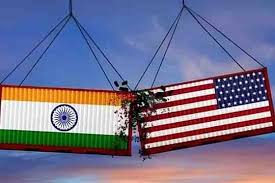
Full India-US Trade Deal Unlikely Soon as Govt Awaits Clarity on Trump Policy

 :
| Updated On: 12-Jun-2025 @ 1:43 pm
:
| Updated On: 12-Jun-2025 @ 1:43 pmSHARE
India and the United States are working towards finalizing an "initial tranche" of their proposed bilateral trade agreement by July 9, but a comprehensive deal may take several more months to materialize. The delay stems from the Trump administration’s ambiguous trade policy, which, so far, has largely focused on using tariffs as leverage to bring countries to the negotiating table. There is a lack of clarity on broader trade objectives, which makes it difficult to frame a lasting and durable agreement.
Sources indicate that for a long-term trade agreement to be viable, the US will need to move beyond a case-by-case approach. One major uncertainty lies in how the tariff reductions promised by the US Trade Representative will be implemented. It is unclear whether these reductions require approval from the US Congress, adding a layer of legislative complexity. Legal challenges to Trump’s policy of reciprocal tariffs have also contributed to the uncertainty over how duty cuts will be negotiated.
Following a meeting between Indian Prime Minister Narendra Modi and former US President Donald Trump in February, both nations had agreed to work towards a bilateral trade deal by the fall of 2025 (September–October). However, the momentum was disrupted when Trump announced new reciprocal tariffs on April 2, only to suspend them later. This unpredictable policy behavior has made stakeholders cautious.
Past trade deals negotiated by the Trump administration with countries like the UK and China were not final agreements, but rather interim arrangements. These deals were characterized by repeated policy shifts and sector-specific focuses, often influenced by political affiliations. For instance, Harley Davidson has long benefited from lobbying efforts to reduce import duties, even though the company exports bikes from its Asian plant. Additionally, Trump's earlier support for reducing car import duties was partly attributed to his ties with Tesla CEO Elon Musk — a relationship that recently soured, adding more unpredictability to the equation.
India, while navigating these discussions, is prioritizing a few key objectives. First, the government wants to ensure Indian businesses benefit from improved market access in exchange for lower tariffs on imports. An agreement could open up the Indian market of nearly 1.5 billion people to US firms, creating a mutual economic benefit. Second, the Indian government is monitoring how the US resets tariffs with other countries, as competitiveness is crucial for Indian exporters. Unlike some developed economies that offer substantial subsidies, India only reimburses actual taxes and duties under its trade support policies. Third, the government is particularly cautious about protecting sensitive sectors, especially agriculture, including staples, and wants to ensure these areas are fully safeguarded in any trade pact.
Currently, the negotiations are focused on goods trade, trade facilitation, customs procedures, and rules of origin. However, India’s key interest in services trade has not yet been addressed in the talks. The delay in a broader agreement reflects the complexities involved and the need for greater policy clarity from the US side.
Contact Us
House. No. : 163, Second Floor Haridev Rd, near Puberun Path, Hatigaon,Guwahati, Assam 781038.
E-mail : assaminkcontact@gmail.com
Contact : +91 8811887662
Enquiry
×
Reporter Login
×